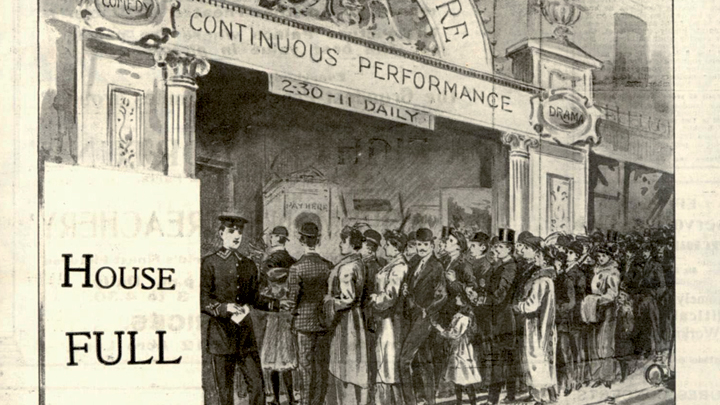The IFI is inviting you to experience A Night at the Cinema in 1914
from August 1st. These unique experience includes early Charlie Chaplin, suffragettes, and WW1 Newsreels.
Marking the centenary of the start of World War I, this special programme of early films recreates a typical night out at a British cinema in 1914. A glorious miscellany of comedies, adventure films, travelogues and newsreels, A Night at the Cinema
in 1914
is released from the 1st August at the Irish Film Institute.
Cinema a century ago was a new, exciting and highly democratic form of entertainment. Picture houses offered a sociable, lively environment in which to relax and escape from the daily grind. With feature films still rare, the programme was an entertaining, ever-changing roster of short items with live musical accompaniment.
Among the highlights of this selection of 14 short films are scenes of suffragettes protesting at Buckingham Palace, Allied troops celebrating Christmas at the Front, a quirky comic short about a face-pulling competition, a sensational episode of the American film serial The Perils of Pauline, and an early aviation display.. There is also a sighting of one of cinema’s greatest icons, Charlie Chaplin, in one of his very earliest films.
This selection of shorts was compiled by the BFI in London. Composer and pianist Stephen Horne, one of Britain’s leading accompanists of silent film, was commissioned to create a new improvised score which reflects the spirit in which the films were made.
Tickets and screening times for A Night at the Cinema in 1914 will be available from the IFI Box Office on 01 679 3477 or online at www.ifi.ie from Monday 28th July.
What’s on Display:
Looping the Loop at Hendon (March 1914)
Pioneering British aviators Gustav Hamel and Bentfield Hucks perform stunts at the legendary Hendon airfield. Although not hard news, this was a topical story.
Palace Pandemonium (May 1914)
The leading campaigner for votes for women, Emmeline Pankhurst, goes to petition the King in person at Buckingham Palace. The campaign for votes for women was very high-profile and often featured in the news. The suffragettes would stage appearances at events for maximum impact.
Austrian Tragedy (July 1914)
Following the assassination of Archduke Franz Ferdinand in Sarajevo, this newsreel shows footage of the Austro-Hungarian royal family, including the wedding of Archduke Karl who succeeded Franz Ferdinand as heir to the imperial throne.
Dogs for the Antarctic (August 1914)
Following the death of Captain Scott, Sir Ernest Shackleton plans another expedition to Antarctica, taking plenty of dogs. This is typical of the ‘magazine’ style film shorts of the time.
Daisy Doodad’s Dial
American Vitagraph studio star Florence Turner ran a film company at the Hepworth studios on the Thames. In this comedy ‘dial’ means ‘face’. The ebullient Daisy Doodad practises for a face-pulling competition and ends up getting herself arrested.
Egypt and Her Defenders
This travelogue of the famous sights of Egypt shows Lord Kitchener as British Consul General before he was made Secretary of State for War. In this film with colour tinting, he is seen reviewing the troops.
Lieutenant Pimple and the Stolen Submarine
Fred Evans was the most popular British comedian of the age, turning out hundreds of ‘Pimple’ films which made a virtue of their low budgets. Here Pimple foils the plans of dastardly foreign spies. If Monty Python had made comedies in 1914 they would look like this.
Scouts’ Valuable Aid (August 1914)
As the nation gears up for war even the young are mobilised to help the war effort … Here a pair of Sea Scouts are on the look-out on the cliff tops for an invading fleet.
German Occupation of Historic Louvain (September 1914)
When Germany invades neutral Belgium, the destruction of the historic town of Louvain and its ancient university library provokes worldwide outrage. This newsreel was presumably filmed by a cameraman from a neutral country.
General French’s Contemptible Little Army
General French, commander of the British army in France, gets the better of the Germans in this lightning sketch by pioneering animator Lancelot Speed. Animation was popular and commonly distributed as part of the newsreels. Cartoons allowed Speed to be splendidly irreverent.
Christmas at the Front (December 1914)
Troops celebrate Christmas at the Front. We’re not told where for reasons of national security. But it’s good to see the boys being well fed before they return to the trenches.
The Perils of Pauline
American imports were always popular and serials were the latest sensation in 1914. In this excerpt, Pearl White stars as Pauline, a feisty heroine pursued by villains eager to get their hands on her fortune and features both an accidental hot air balloon trip and a spectacularly daring rescue from a burning building.
The Rollicking Rajah
Years before the arrival of the ‘talkies’, this Vivaphone song film (which wonderfully shows the ladies fashions and dance moves of the day) would have been accompanied by a synchronised sound disc, which is now lost. The song is recreated here from the surviving sheet music. The Vivaphone was a British sound on disc system pioneered by Cecil Hepworth.
A Film Johnnie
In 1914, Hollywood is born and British comedian Charles Chaplin is its greatest star. He explodes onto British screens in summer of that year. This is one of his very first films and is, appropriately, set in a cinema.

